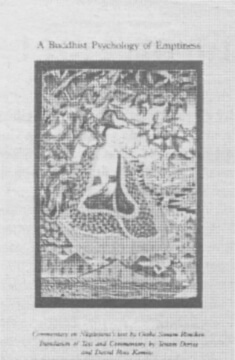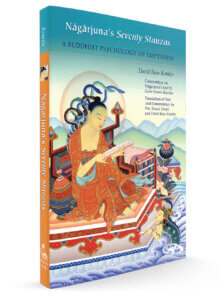| The following article is from the Winter, 1999 issue of the Snow Lion Newsletter and is for historical reference only. You can see this in context of the original newsletter here. |
Nagarjuna's Seventy Stanzas
A Buddhist Psychology of Emptiness
By David Ross Komito
Commentaries by Geshe Sonam Rinchen
Notes by Geshe Sonam Rinchen
Translated by Tenzin Dorjee & David Ross Komito
226 pp., notes, bibliography, index
ISBN 0-937938-39-4 #NASEST $16.95

For almost two thousand years Nagarjuna's teachings have occupied a central position in Mahayana Buddhism. An essential part of the study and practice in the great Indian Buddhist monastic universities, these teachings were later incorporated into the Tibetan monastic programs which modeled their curricula on their Indian predecessors.
This volume contains a translation of Seventy Stanzas, a fundamental work of Nagarjuna on the Madhyarnika system of Buddhist philosophy, along with a commentary on it from the Prasangika viewpoint by Geshe Sonam Rinchen which is based on traditional sources yet created expressly for the contemporary reader. In addition, David Komito summarizes basic Buddhist doctrines on perception and the creation of concepts which have traditionally served as the backdrop for Nagarjuna's teachings about how people consistently misperceive and misunderstand the nature of the reality in which they live and the means through which they experience it.
This book will be of interest to practitioners and scholars of Buddhism as well as psychologists who seek a deeper understanding of Buddhist psychology and epistemology.
David Komito received his Ph.D. from Indiana University. Since then he has published numerous articles on Buddhism and on the relationship of Buddhism and psychotherapy. He has taught and administrated at Amherst, Mt. Holyoke, Wesleyan, and Stanford and is currently Associate Professor of Religious Studies and a Dean at John F. Kennedy University.
Geshe Sonam Rinchen was born in Tibet in 1933. He studied at Sera Je Monastery and in 1980 received the Lharampa Geshe degree. He is currently resident scholar at the Library of Tibetan Works and Archives in Dharamsala, India, where he teaches Buddhist philosophy and practice.
Venerable Tenzin Dorjee has been on the teaching staff of the Library of Tibetan Works and Archives in Dharamsala, India.
Stanza 19
/dngos dan dngos rned cig car med/
/dngos med med na dngos po med/
/rtag tu dngos po'ng dnos med gyur/
/dngos med med par dngos mi srid/
Response: An object cannot simultaneously arise as a functional phenomenon and cease as a nonfunctional. phenomenon. If a nonfunctional phenomenon does not exist then afunctional phenomenon cannot exist because an object cannot arise and endure as afunctional phenomenon without depending on its cessation as a non-functional phenomenon, or else it would exist at all times, if a non-functional phenomenon which is different from a functional phenomenon does not exist then it is impossible for a functional, phenomenon to exist.
Functional phenomena are produced by causes and conditions, and are themselves the causes and conditions for other phenomena. Non-functional phenomena are not produced by causes and conditions and are not themselves the causes and conditions for other phenomena. Thus it would be contradictory to say that a phenomenon can simultaneously arise as a functional phenomenon and cease as a non-functional phenomenon. Rather, a phenomenon must sequentially arise as a functional phenomenon and cease as a nonfunctional phenomenon. For this to be the case, functional phenomena and non-functional phenomena must be different and must exist in mutual dependence because if a phenomenon does not arise as a functional phenomenon, it could not have been produced by causes and conditions and could not produce results. Yet, if it does not cease as a non-functional phenomenon, it will never cease producing results and will be permanent. Thus a functional phenomenon cannot exist without a non-functional phenomenon and a non-functional phenomenon cannot exist without a functional phenomenon; they are mutually dependent, but different. Since they occur at different times, they cannot arise simultaneously but must arise sequentially, and they must lack inherent existence. This is because phenomena that exist inherently exist independently, so if they had inherent existence and arose simultaneously, then they would exist permanently at all times, which is impossible. If they had inherent, independent existence and arose sequentially, then they would be two different things without relationship. Thus no phenomenon can have inherent existence, but phenomena must arise and cease without inherent existence, and so Buddha spoke of arising and ceasing.
What do we mean by arising, enduring, disintegrating and ceasing? These refer to four characteristics of a composite thing. Arising or production means the fresh arising of an identity of a thing from causes and conditions. Enduring refers to the abiding of the former continuity of a thing. Disintegrating refers to that which does not abide in the second moment of the time of its formation. Ceasing refers to the initial moment of a thing changing into the subsequent moment of a thing. When the process of disintegration has reached completion and the initial moment of a thing has changed into the subsequent moment of a thing, then the thing has ceased; it has gone beyond the limit of the original moment.
Stanza 20
/dngos po med par dngos med min/
/rang las min zhing gzhan las min/
/de lta bas na de med na/
/dngos po med cing dngos med med/
If there is no arising and enduring, which are functional phenomena, then there can be no disintegration or cessation, which are nonfunctional phenomena; so the latter would be completely non-existent. If a phenomenon were to exist inherently it must have arisen from its own nature or from some other nature, but it cannot arise from its own nature and because a phenomenon cannot have a different nature than its cause, so it cannot arise from some other nature which has inherent existence. Because of that, a functional phenomenon cannot exist inherently and because a functional phenomenon cannot, exist inherently, so a nonfunctional phenomenon cannot exist inherently.
Functional phenomena and non-functional phenomena are mutually dependent on each other for their existence, which means that they do exist conventionally. This is because arising is the characteristic of functional phenomena, while complete disintegration and cessation are the characteristics of non-functional phenomena. If a phenomenon didn't arise, how could it disintegrate completely and cease? Thus, without functional phenomena, nonfunctional phenomena would be completely non-existent. Likewise, we have already shown how the existence of functional phenomena is dependent on the existence of nonfunctional phenomena; thus they are mutually dependent for their existence, and since they are not independent they cannot have inherent existence.
If someone were still to assert that a functional phenomenon could exist inherently, then we would have to investigate whether it had arisen from its own nature or from another nature. Nothing can arise out of itself, so no phenomenon can arise from its own nature. However, no phenomenon can have a nature which is different than its cause, so it could not arise from some other nature which had inherent existence. So in neither case can a functional phenomenon exist inherently, and because nonfunctional phenomena exist in dependence on functional phenomena, so non-functional phenomena must also lack inherent existence.
Stanza 21
/yod pa nyid na rtag nyid dang/
/med na nges par chad nyid yin/
/dngos po yod na de gnyis gyur/
/de phyir dngos po khas blangs min/
If a phenomenon were to exist inherently it should be permanent. If a phenomenon were to 1) disintegrate completely then you must accept the annihilationist view. If a phenomenon were to exist inherently it would either exist permanently or else undergo complete disintegration: it. cannot occur in a way which is different than these two. Therefore one should not assert that a phenomenon has inherent existence.
Phenomena which exist inherently cannot undergo change. Thus, over the three times a phenomenon with inherent existence must either remain permanent or else be completely non-existent. These are the only two possibilities for an inherently existing phenomenon, because if it can't change it must either remain the same at all times, i.e., be permanent, or else have disintegrated completely, i.e., become completely non-existent. The former is the externalist view and the latter is the annihilationist view. Since these logical consequents are both extreme views, one should not assert that phenomena have inherent existence.
If we perform this type of analysis through reasoning, we will come to understand that all phenomena lack inherent existence and with this understanding we will be able to eliminate the ignorance of grasping at the true existence of all things. The ignorance of grasping at the true, inherent existence of things is different than the ignorance of grasping at the two extreme views about things, which are the overestimation of the nature of a thing, i.e., that it exists permanently, or the underestimation of the nature of a thing, i.e., that it is completely destroyed or doesn't even exist conventionally. The two extreme conceptions are not directly-contradicted in their apprehension of the object by the mind which understands that the referent object of the ignorance of grasping at true existence does not exist. But if through meditation we familiarize ourselves with the mind which understands the lack of inherent existence of things, then we will later be able to eliminate the mind which grasps at those two extremes of overestimation and underestimation.


